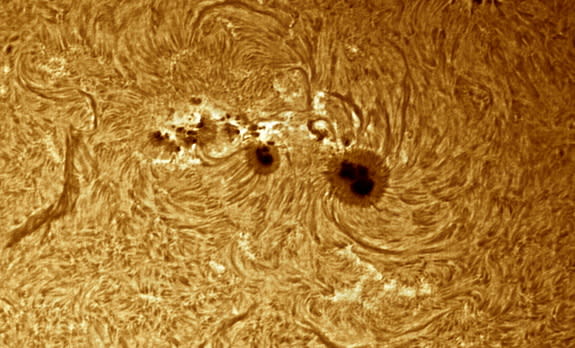Monster Sunspot Dominates Sun Photos by Amateur Astronomers
Amateur astronomers have safely captured amazing views of a colossal sunspot seven times the size of Earth that is currently making its way across the face of the sun.
Stargazer Giuseppe Petricca of Sulmona, Italy, sent SPACE.com a series spectacular images of the massive, active sunspot region AR1944. The sunspot unleashed the first major solar flare of 2014 on Tuesday (Jan. 7) in the form of an X1.2-class sun storm, which is the strongest class of solar flares the sun experiences.
"The sunspot is really big, visible even to the naked eye, using the appropriate filters," Petricca wrote in an email, adding that some high level clouds helped in filtering the solar light. [See more photos of the monster sunspot and solar flare]
The images were taken Jan. 7 from Sulmona, Italy using a Nikon P90 bridge camera on a tripod (ISO 64, f/6.3, 1/1200" exposure). Petricca used simple welding glass on the HDR filtered images, giving those images a green color. "The spot cores and structures are easily recognizable even with this little magnification," Petricca said.
On Wednesday (Jan. 8), amateur astronomer Andrew Kwon of Mississauga, Ontario, snapped his own view of sunspot AR1944 from his backyard observatory. Kwon's image revealed a zoomed-in view of the enormous sunspot, as seen through a 60mm solarmax II H-Alpha telescope and an AS120mm monochrome camera.
AR1944 is "the largest sunspot group I can recall seeing [in] four years of solar observing," Kwon wrote in an email.
Warning: Never look directly at the sun through binoculars, telescopes or with your unaided eye. Severe eye damage, and even blindness, can result. Astronomers use special filters to safely observe the sun and protective glasses are required for solar eclipse viewing.
Tuesday's massive solar flare delayed commercial spaceflight company Orbital Sciences’ plans to launch a landmark cargo delivery flight to the space station today (Jan. 8) due to concern over space weather radiation.
The sun is currently in an active phase of Solar Cycle 24. Solar weather cycles average 11 years, with Solar Cycle 24 beginning in 2008.
To see more amazing night sky photos submitted by SPACE.com readers, visit our astrophotography archive.
Editor's note: If you have an amazing night sky photo you'd like to share for a possible story or image gallery, please contact managing editor Tariq Malik at spacephotos@space.com.
Follow SPACE.com on Twitter @Spacedotcom. We're also on Facebook & Google+. Original story on SPACE.com.
Copyright 2014 SPACE.com, a TechMediaNetwork company. All rights reserved. This material may not be published, broadcast, rewritten or redistributed.




